For self-proclaimed feminist Prime Minister Justin Trudeau, Canada has a role to play to head off predictions global economic gender parity will take 117 years to become a reality.
Trudeau was questioned on solutions to accelerate the closing of this gap during a live global town hall hosted by The Huffington Post Canada on Monday. University of Toronto student Bushra Ebadi asked Trudeau what Canada could do to bring gender parity to fruition in her lifetime.
"I think there’s not one solution, there’s multiple, multiple solutions that can be pursued at the same time," Trudeau told Ebadi and the audience.
"So how do we do it? There are top-down decisions to take, like I did in appointing a gender-equal cabinet."
"There are other decisions we need to take around legislative tools, for example not turning it into a bargaining element in negotiation between a union and an employer," he continued. "Saying, this is a core value that has to be achieved."
Trudeau also listed education in schools, "cracking down on patriarchal thinking and gender-based violence,” and supporting women’s reproductive rights as solutions to gender inequality.
“I mean there’s an entire social change that has to go... there’s a lot of work still to do,” Trudeau said. “But I know there are an awful lot of people who are pulling together to work exactly on this, because it matters so deeply; not just to Canada, but to the world.”
Political representation
In spite of making up half the workforce, women in Canada earn 73.5 cents to every dollar made by men, according to a new report by StatsCan for The Globe and Mail, an issue that’s often attributed in part on the dearth of higher-paying senior positions offered to women.
When Trudeau appointed his gender-balanced cabinet in November with his famous “Because it’s 2015” quip, his move had both political and economic effects for his ministers.
As members of Parliament, Trudeau’s 15 female ministers earned a base salary of $167,400, equal to their male contemporaries. By becoming cabinet members, they now earn $80,000 more, for a total annual income of $247,500.
Increased female representation in cabinet hasn't had an immediate economic impact for women, but there’s evidence south of the border that it’s a smart move. When FiveThirtyEight tracked how pay parity was related to female representation in American politics, they found that the wage gap was narrower in U.S. states with more women in office.
Legislation

There are two types of legislation that can address the wage gap — pay equity, where female-dominated occupations are paid the same as male-dominated occupations of comparable value, and pay equality, where all genders working an identical job are paid equally.
In Canada, the Ontario Pay Equity Act was first enacted in 1987 to prevent wage discrimination against employees, including female workers. Similar acts in other provinces and territories have followed.
Approximately 10 to 15 per cent of wage gap cases are due to discrimination, states the Ontario Human Rights Commission, which counted only reported cases of pay inequity.
But pay equity and pay equality laws are not standardized across the country. Provinces like Saskatchewan, Newfoundland and British Columbia have no pay equity legislation. Alberta, which has no pay equity or pay equality legislature, has the widest gender wage gap in Canada.
The NDP introduced a pay equity motion to the Liberal government in February. The motion called for a parlimentary committee to examine pay inequity and passed the House of Commons, with support from the NDP and the Liberals.
The gender pay gap is wider for marginalized women: lesbian couples, women with disabilities, Indigenous women, racialized women, newcomers, and transgender women all face higher amounts of pay inequity.
Currently, Labour Canada does not enforce how employers practice pay equity or take wage gap complaints. Instead, it encourages workers to consider filing a complaint with the Canadian Human Rights Commission.
Education

More women (64.8 per cent) than men (63.4 per cent) earned a post-secondary education in Canada, according to data from the 2011 National Household Survey. Past Statistics Canada studies point to differences in early development and in the way male and female children are socialized in terms of parental expectations around school — girls spend more time on homework at an earlier age, develop stronger study habits and are more aware of the correlation between education and income.
But although women are now the majority on campus, they still battle rape culture, pick-up artists and men's rights groups vying to carve some influence with the student body.

And women's higher education also doesn't translate to guaranteed better-paying jobs. Women aged 25 to 29 with undergraduate university degrees earned 89 cents to every dollar made by male graduates according to 2005 StatsCan info; women in the same age group with college degrees made 80 cents to every dollar earned by their male counterparts.
Patriarchal thinking
Patriarchal thinking centres around the idea that men or traditionally "male" concepts are dominant or valued over others. When it comes to gender parity, it can influence the workforce through occupational segregation.
Recent info from Catalyst revealed segregation in the Canadian workforce in areas such as bricklayers, automotive technicians, electricians, among others which are overwhelmingly male. On the flipside, dental technicians, early childcare educators and office administrative assistants were predominantly female.
Many “female” jobs such as nursing, childcare, and housekeeping are among the lowest-paying jobs. Solutions to occupational segregation suggest men and women need to re-socialize how industries can be more accessible for women.

Researchers from Wharton and McGill University looked into the causes of gender segregation in the workplace and found that employer behaviour wasn't the sole factor — women themselves were avoiding certain types of jobs, such as investment banking, for specific reasons. They based their decisions on factors that included pay and schedule flexibility, their ability to identify with the job, and their belief they could get the job if they applied for it.
“Women just didn’t think they would get jobs there, so they didn’t apply,” researcher Matthew Bidwell said — even though they were just as likely to get the job as male applicants if they did apply. As solutions, he and research partner Roxana Barbulescu concluded that creating flexible workplaces that accommodated family and caregiver needs, and changing the way roles are structured to be more gender-neutral, could help erode occupational segregation.
Gender-based violence

The United Nations reports that one in three women has faced physical and/or sexual violence. But violence against women doesn't affect just one gender, there are widespread implications. Economy-wise, Statistics Canada reports that when women are victimized, their productivity at work falls, thus impacting how effective they are as employees.

In a study, the Department of Justice Canada found that spousal violence against women cost Canadians $7.4 billion in 2009 alone; the majority of that was from intangible costs that can't be recovered, as suffering, loss of affection and loss of life.
Women’s reproductive rights
Alternatives to legal abortions push many women to illegal and underground services, which endanger their welfare. A World Health Organization report revealed that unsafe abortions counted for 13 per cent of all maternal deaths.
The right to choose parenthood is a tenet of reproductive justice that Trudeau has long championed, with his commitments to pro-choice law-making evident in much of his campaigning. In 2014, he announced anti-abortion Liberal candidates could not run for the Liberals, a stance he later clarified. The Liberals' pro-life stance was expanded during federal elections last year, when the party said abortions could be legally funded across the country through the Maternal, Newborn, and Child Health Initiative.
Internationally, the Trudeau government announced Monday it would commit millions of dollars in funding toward reproductive health services globally, including a UN contraception-supply program, but did not commit any of that funding toward abortion services in relevant countries.
“Ensuring universal access to sexual and reproductive health and rights, and empowering women and girls is central to achieving gender equality,” Ms. Bibeau said in The Globe and Mail. “This is why our government is proud to help address these critical health issues facing vulnerable young women, mothers and newborns around the world.”